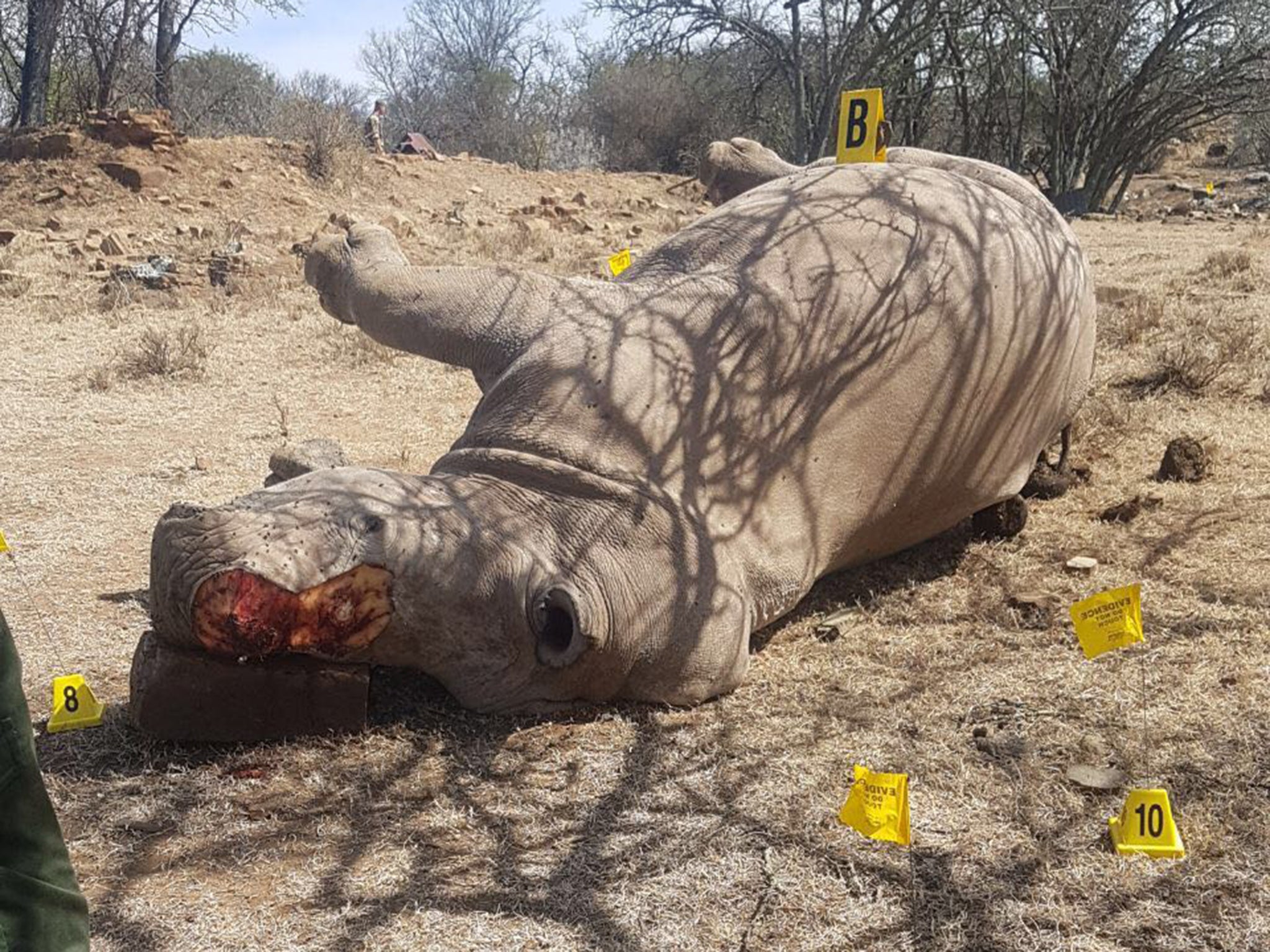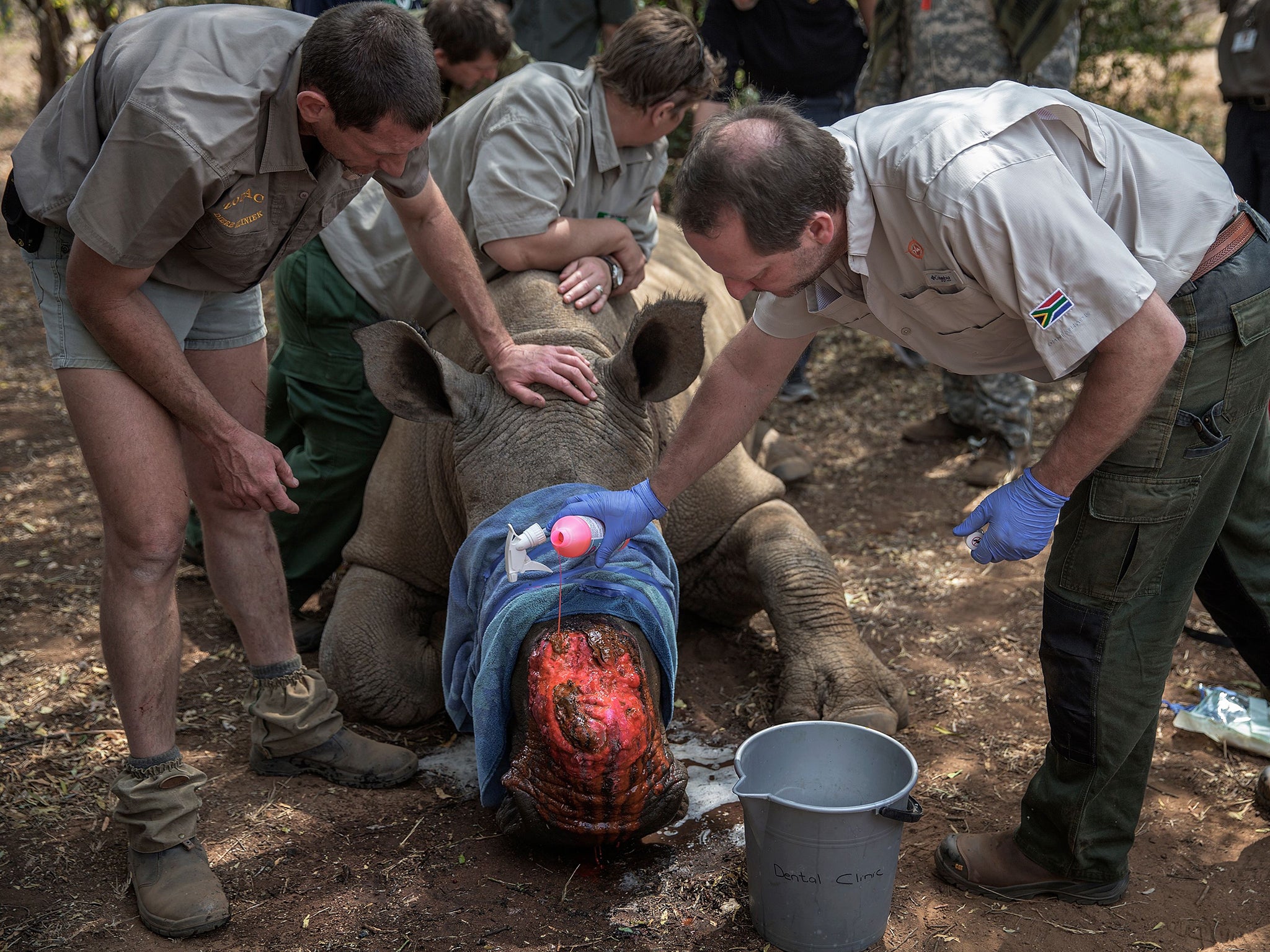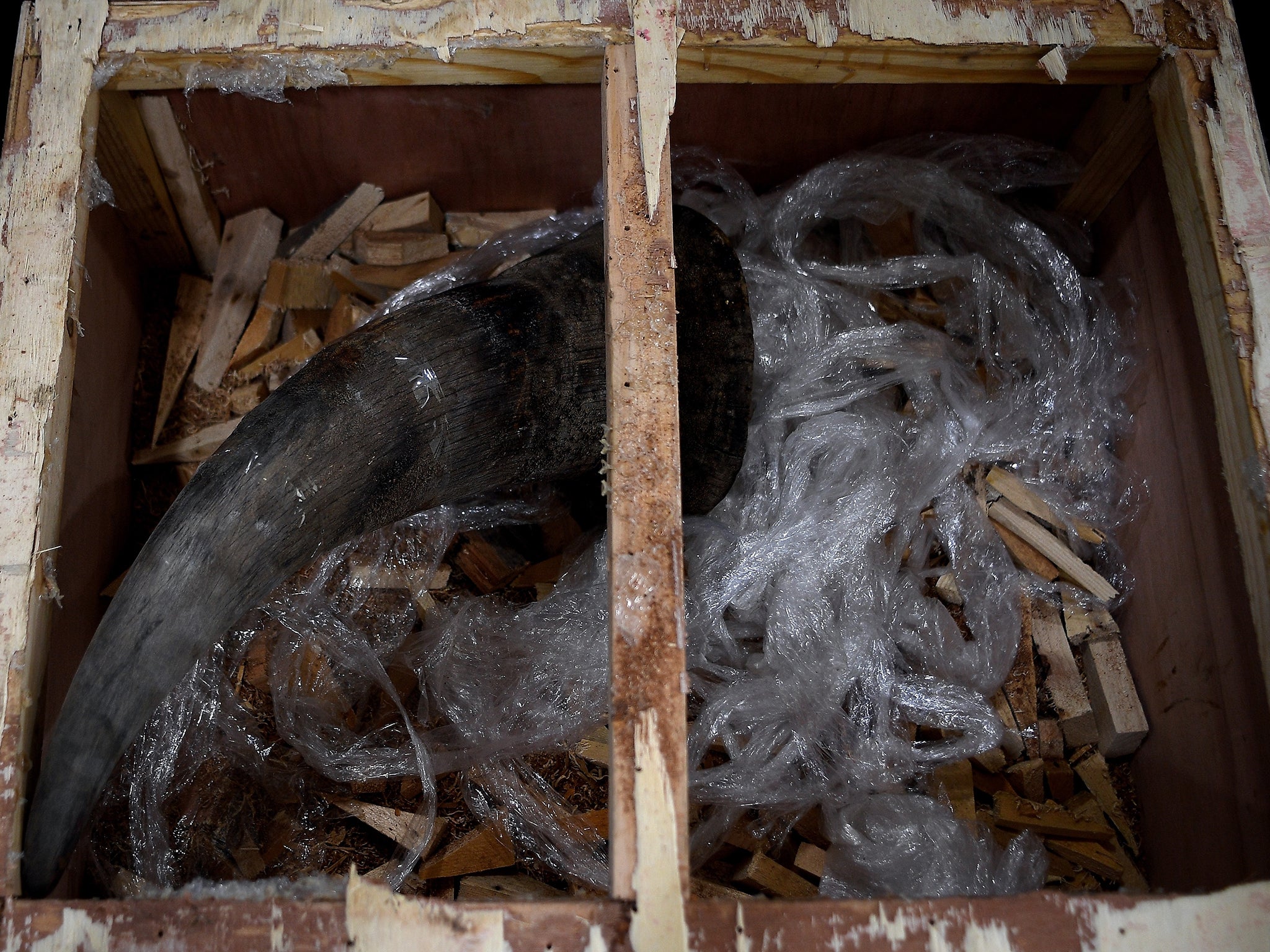How a poaching scene is a crime scene
Researchers in South Africa are turning to genetic fingerprinting to track down poachers for prosecution

Your support helps us to tell the story
From reproductive rights to climate change to Big Tech, The Independent is on the ground when the story is developing. Whether it's investigating the financials of Elon Musk's pro-Trump PAC or producing our latest documentary, 'The A Word', which shines a light on the American women fighting for reproductive rights, we know how important it is to parse out the facts from the messaging.
At such a critical moment in US history, we need reporters on the ground. Your donation allows us to keep sending journalists to speak to both sides of the story.
The Independent is trusted by Americans across the entire political spectrum. And unlike many other quality news outlets, we choose not to lock Americans out of our reporting and analysis with paywalls. We believe quality journalism should be available to everyone, paid for by those who can afford it.
Your support makes all the difference.South African authorities long had eyes on Rogers Mukwena. They knew the former schoolteacher was wanted in Zimbabwe for poaching rhinoceroses and selling their horns, which can command hundreds of thousands of dollars.
He’d jumped bail and fled to northern Pretoria, but it was vexingly difficult to catch and prosecute him – until a scientist helped make the case against him with rhino DNA.
His subsequent conviction resulted from a new tactic in wildlife preservation: the genetic fingerprinting methods that have been so successful in the criminal justice system are now being used to solve poaching crimes.
First, researchers in South Africa had to build a large database of genetic samples drawn from African rhinoceroses. The DNA would be used to match a carcass to a particular horn discovered on a suspected poacher or trafficker, or to rhinoceros blood on his clothes, knives or axes.
To make that possible, Dr Cindy Harper, a veterinarian at the University of Pretoria, and her colleagues collected DNA from every rhinoceros they could find – more than 20,000 so far. They have taught park rangers how to retrieve blood, tissue or hair samples from every rhinoceros that is killed, dehorned or moved.
The rangers have learned forensic crime-scene principles and the importance of the so-called chain of custody to ensure that the samples are not corrupted. Harper’s lab performs the analysis and stores DNA fingerprints.

The scientists’ database, which they call Rhodis, is modelled after Codis, the FBI system used to link the DNA of suspects to evidence at a crime scene.
The approach is promising, said Crawford Allan, senior director of Traffic, which monitors illegal wildlife trade at the World Wildlife Fund.
A poaching scene is a crime scene, he said: “If you want to get through detection and investigation and prosecution, treat it as a crime scene and use forensics.”
Poaching has escalated exponentially in the past decade, he noted. More than 7,000 rhinos have been killed in the past 10 years. The World Wildlife Fund estimates that 20,00 to 30,000 African elephants are killed each year for their tusks.
Their tusks and horns are trafficked through experienced criminal networks. “You really need sophisticated tools to help solve these crimes,” Allan said.
The rhino project provides “a ‘cold hit’ database,” said Stephen J O’Brien, referring to the identification of a perpetrator by DNA when there are no other apparent clues.
O’Brien, an expert on DNA fingerprinting and chief scientific officer of the Theodosius Dobzhansky Centre for Genome Bioinformatics at St. Petersburg State University in Russia, is co-author of a new paper, published in Current Biology, describing the anti-poaching effort.
A similar attempt to use DNA to convict poachers is led by Sam Wasser, director of the Centre for Conservation Biology at the University of Washington. His group’s focus is African elephants.
Over a period of 15 years, he and his colleagues have collected and analysed DNA from dung to create a map of the ranges of various elephant groups based on their genetic differences. It helps show where ivory seized from poachers originated.
The project has not linked specific carcasses to specific tusks recovered from traffickers. But the analysis has provided valuable clues about the regions in which poachers are operating.

“To our surprise, the ivory was consistently coming from two areas,” Wasser said. Tusks from savanna elephants were initially coming from south-eastern Tanzania and northern Mozambique, the data showed, but the illegal trade then shifted northward to southern Kenya.
Tusks from forest elephants originated in a small triangular area in northeast Gabon, north-west Republic of Congo, and south-eastern Cameroon.
“Instead of focusing everywhere, if we really want the big criminals we should focus on those two spots,” Wasser said.
The sale of ivory and rhino horns is hugely lucrative. Rhino horns may bring $60,000 (£43,000) or more per kilo. A horn generally weighs a few kilos, but a few have been as heavy as 10kg, or about 22 pounds.
“Pound for pound, a rhino horn is worth more than heroin or gold or platinum,” Allan said. And prosecutions are so rare that the risks for the traffickers are “very low”.
The poacher sells horns to a trafficker, who disguises them and ships them to destination countries, mainly Vietnam and China. Some horns are carved into jewellery while still in South Africa, which can make it extremely difficult to trace them.
Most horns are ground and used as medicine in Asia, believed to cure cancer, impotence – or, Allan said, “you name it”. More recently, people in Asia have begun wearing beads or bangles made from rhino horns thought to have curative powers and to be status symbols. Some horns are made into ceremonial cups.
Elephant tusks currently sell for $1,000 a kilo, Wasser said. Unlike rhino horns, which are shipped in relatively small volumes, traffickers typically collect and ship at least half a ton of ivory, or 500kg, in a container.
Some seizures have uncovered as much as 7 tons of ivory in a single shipment, Wasser said. Ivory is primarily bought by collectors or as an investment.
Wasser’s primary target is traffickers, not poachers. Even when poachers are caught and convicted, he said, “there are 10 more waiting in line to replace them”.
But traffickers form the basis of the business that makes poaching profitable. “The analogy is, are you after a serial killer or a one-time murderer?” he asked.

To catch a serial killer, Wasser added, authorities require “intelligence-based forensics to prevent future crimes”.
Harper also hopes to disrupt the criminal networks shipping contraband – in this case, rhino horns – to destination countries. So far, the rhino database has been used to convict hunters and traffickers in South Africa, Namibia, Kenya and Swaziland.
But the group has not disrupted the criminal conglomerates at the top of the chain, she said.
The rhinoceros project began in 2010, when poaching was skyrocketing. Thirteen were poached in South Africa in 2007; more than 1,000 are now killed each year.
In 120 criminal cases completed or still pending, Rhodis has linked DNA on horns, equipment or clothing to particular carcasses, Harper said. But it can take years for a case to move through the courts and end in a conviction.
The first successful such conviction involved a Vietnamese smuggler who was caught with seven horns at OR Tambo International Airport in Johannesburg in 2010. Two were matched to carcasses, and he was sentenced to 10 years in prison.
But the case involving Mukwena was one of the first to involve a well-known smuggler. He was arrested on 16 January 2012, after a police officer spotted him walking across a field carrying a black bag.
When the officer confronted him, Mukwena dropped the bag and ran. It contained three rhinoceros horns, two from a cow and one from her calf.
Apprehended, Mukwena admitted to killing the cow but said an accomplice had killed the calf because it was bothering him.
© New York Times
Join our commenting forum
Join thought-provoking conversations, follow other Independent readers and see their replies
Comments